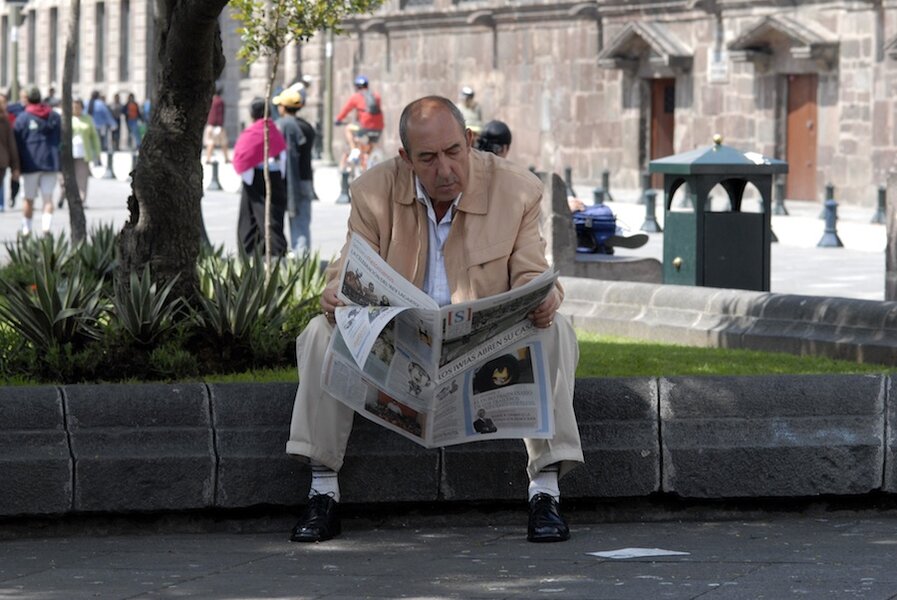Ecuador's Diario HOY moves online: A sign of more to come in Latin America?
| Quito, Ecuador
A printing press sits idle in Diario HOY, one of Ecuador's most respectable dailies, with a roll of blank paper still fed into the machine.
For 32 years Diario HOY was published on this press, but on June 29 the final edition came out with this headline: “HOY closes one chapter, and starts another.”
This new chapter appears to be part of an overall evolution in Latin American media where digital is proving to be a natural step, given a rapid rise in internet users, and part of a decline of advertising and readers for daily papers as in the US and Europe.
But the change for Diario HOY plays off some unique Ecuadorian factors as well, namely a recent communications law, which limits freedom of speech, as well as advertising and private investment in independent media. Some have used the word "war" to characterize media developments in Ecuador.
“We’ll see how it goes,” says William Morocho, a page designer with the paper. Among the changes are a more robust online presence and scaling back to only a weekend print edition. The hope is to tap into a growing market of news consumers online.
News organizations in Latin America "have never had such a large audience as they have now,” says Rosental Alves, director of the Knight Center for Journalism in the Americas at the University of Texas at Austin, referring to both print and online platforms.
In 2013, newspapers in Latin America grew nearly 3 percent while circulation went down across the United States and Europe, according to the World Association of Newspapers and News Publishers. Overall, circulation across Latin America makes up only a fourth of that of the United States, but Mr. Alves points to the regional trend of embracing digital-first and social media engagement business models as helpful in continuing this trend in the future.
What were once hyperlocal papers now have access to global web audiences. This is due, in part, to Latin America playing host to the fastest-growing population of internet users in the world. Internet use grew 12 percent between 2012 and 2013, when it reached 147 million users. It's expected to climb another 11 percent over the next three years.
A question of free press?
Despite most newspapers in Ecuador maintaining a strong online presence, Diario HOY was one of the first papers to feel forced to end its daily print edition, says the paper's director, Jaime Mantilla. He places the blame largely on the Ecuadorean government and its year-old “Ley de Comunicación.”
The wide-ranging law consists of 109 rules meant to reform the press in Ecuador — monitoring and even issuing fines on everything from the publication of sexist content, to salaries for journalists and, as a recent public complaint shows, the failure of newspapers to “give enough space and detail” to covering a government state visit.
“The Communication Law is terribly restrictive not only to journalists, but to people’s rights to information,” says Mr. Mantilla. “It has been presented as a way for citizens to have better access to the media — but that’s not the case. The law does away with any possibility of a free press in Ecuador.”
According to Mantilla, Diario HOY’s profits fell by more than a half between 2007 and 2013, due to a drop in advertising sales. But for this, he also blames the government, which he refers to as the “main ad buyer in the country.”
But Carlos Ochoa Hernandez, head of the government agency that enforces the media law (Supercom), has refuted those claims. “It’s a bold statement, to say the least, that HOY pretends to blame the law for the failed administration of the paper, which led to the end of its print edition.”
One of the architects of the Ley de Comunicacion, Romel Jurado, is now a consultant with Supercom. He refers to the media climate here as a “war.”
“There is an almost irrational confrontation between those members of the media in the private sector who say the law is bad, and others, on the government side, who aren’t willing to recognize that the law can be improved,” says Mr. Jurado.
One thing that all sides seem to agree on is a media future in Ecuador, and elsewhere in Latin America, that will be increasingly, and inevitably, digital.
Sitting on a little wooden stool behind her newspaper stand, Beatriz Condo says she has been selling newspapers on Quito’s Plaza Grande, just blocks from the presidential palace, since 1997. Diario HOY has been a favorite among her customers.
“But in the past couple of years, I have barely sold two or three copies on any single weekday,” she says. “Now all the news is available faster, and free, online. Eventually, I may have to sell something other than newspapers.”





